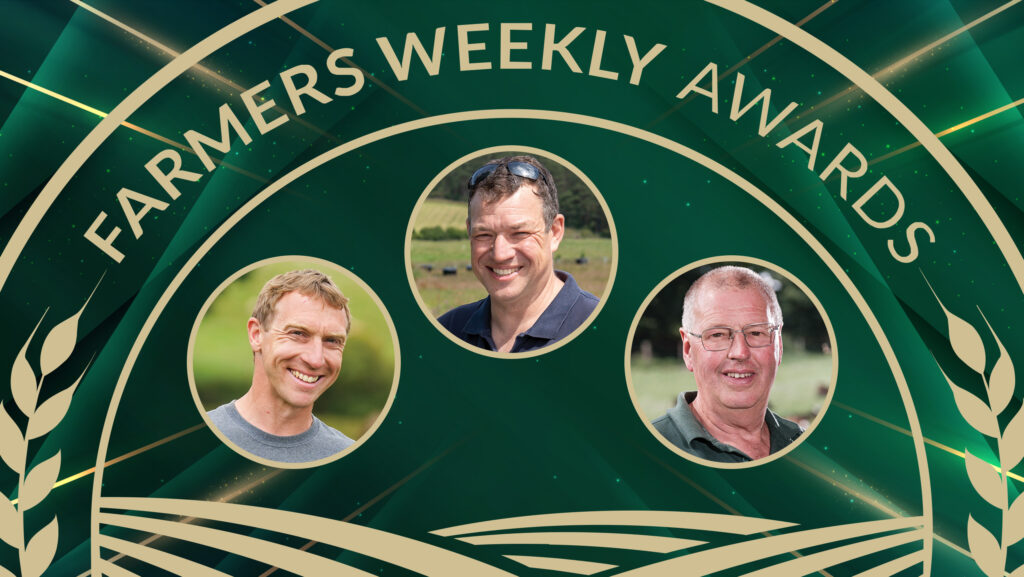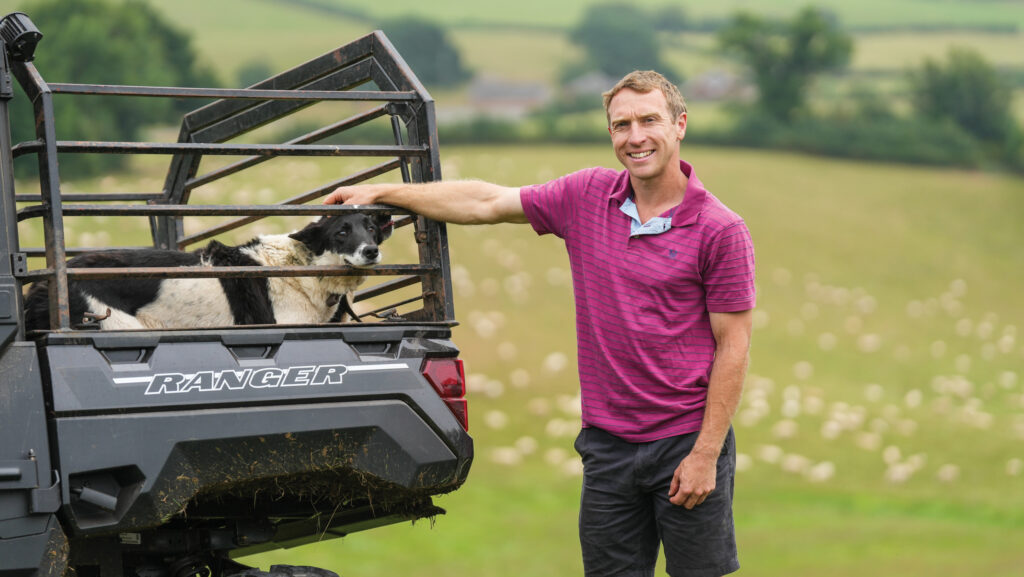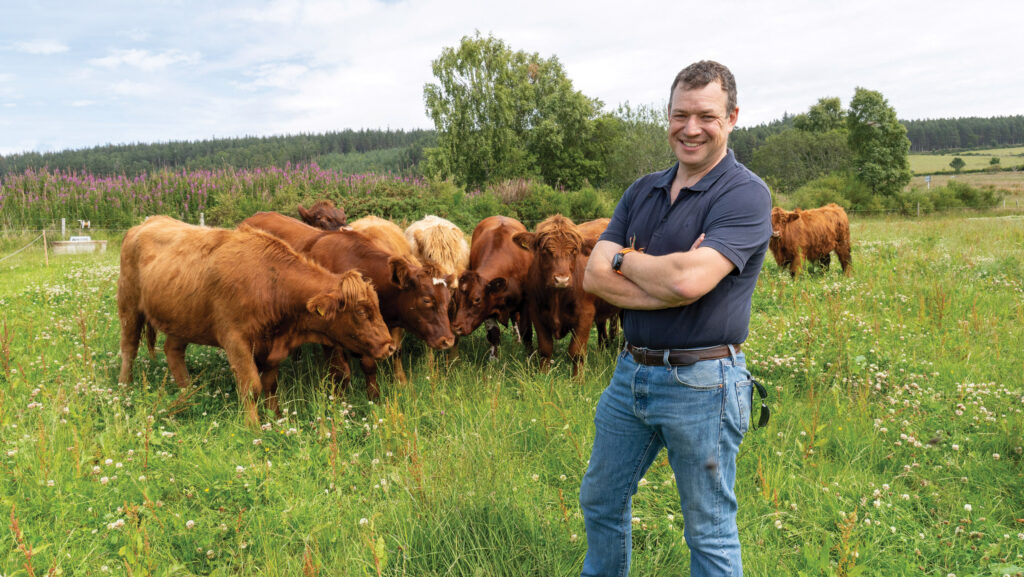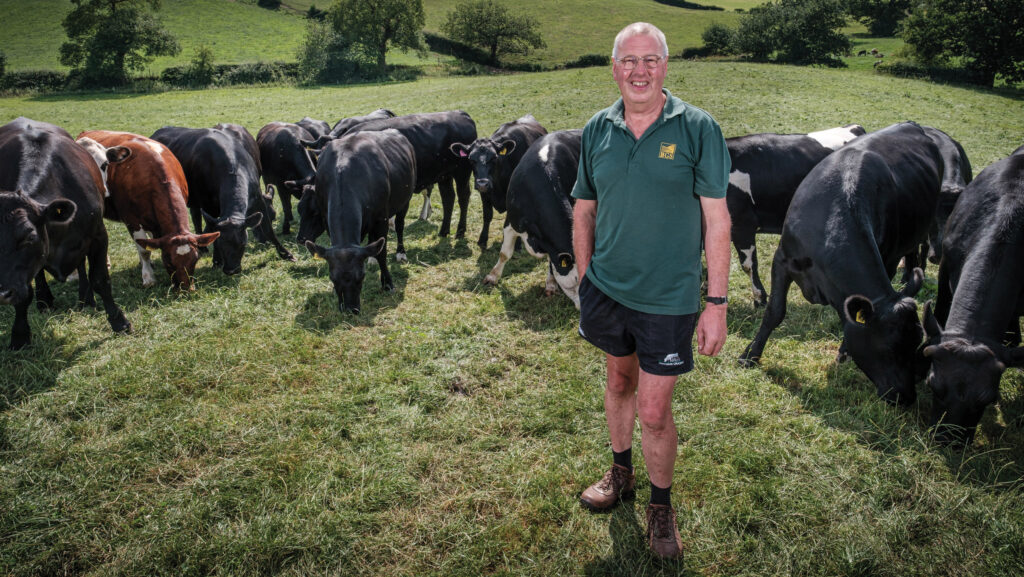FW Awards: Meet the 2025 Grassland Manager of the Year finalists
 Chris Berry, Jock Gibson and Graham Park © Emily Fleur, Angus Findlay, Jim Varney
Chris Berry, Jock Gibson and Graham Park © Emily Fleur, Angus Findlay, Jim Varney Rotational and deferred grazing strategies are helping three livestock farmers reduce their cost of production.
See also: FW Awards 2025: Meet the finalists
Finalists
- Chris Berry, Higher Thornton Farm, Devon
- Jock Gibson, Edindale Farm, Morayshire
- Graham Parks, Overbank Farm, Cheshire
The Judges
- Independent judge James Daniel is a grassland and livestock consultant who runs Precision Grazing.
- Farmers Weekly’s 2024 Grassland Manager of the Year, James Tweedie, produces milk from a herd of spring-calving dairy cows in Cumbria.
- Debbie James is a freelance writer at Farmers Weekly, combining journalism with dairy farming on a coastal grassland farm in Pembrokeshire.
Chris Berry, Higher Thornton Farm, Devon

Chris Berry © Emily Fleur
Switching to rotational grazing and reseeding two-thirds of the grazing platform with herbal leys have produced an extra 2.5t dry matter of grass/ha a year for beef and sheep farmer Chris Berry.
This has also saved him more than £60,000 a year.
Eight years ago, Chris stepped out of what he now sees as the comfort zone of set stocking, and the “traditional thinking” principles he had applied to grassland management, and sub-divided most of his 180ha farm into paddocks.
Grass yield has since increased to an annual average of 9t dry matter (DM)/ha, up from 6.5t, and output now averages 280kg deadweight/ha, compared with 240kg/ha in 2017.
The system has also enabled Chris to save £353/ha a year on input costs, with spend on fertiliser and purchased feed down – and a better work-life balance.
Grassland management
Shallow sandy soils in an area where annual rainfall averages 889mm can limit production during the growing season.
However, the advantage is that Chris only houses finishing cattle or under-conditioned heifers.
Cows winter-graze deferred grass supplemented with hay bales. Depending on grass availability, weaned calves at pasture are fed the better-quality silage and deferred grass for about 90 days.
And grazing agreements with local farms mean ewes and lambs can move off farm for a couple of months each year and run on an all-grass system.
By improving grass growth and utilisation year on year, all cattle and lambs are finished or sold as forward stores by late autumn.
Only breeding stock and weaned calves are carried through the winter. This has cut total concentrate use to 10t/year, down from 100t under set stocking when home-grown rolled barley was fed.
Chris is a big advocate of co-grazing cattle and sheep using a leader-follower system, giving weaned lambs first bite ahead of cows and dry ewes.
Mixed grazing throughout the year means he often has just three or four grazing groups rotating around the farm.
Groups are moved every two to four days and paddocks rested for 30 days, increasing to 40-50 days during dry weather.
Fertiliser application is never more than 10kg/ha and is used strategically to lift average farm cover if needed.
Reseeding and silage
Herbal leys established on 70% of the grazing platform have been a “game changer”, countering the challenges of growing feed in dry summers.
Plantain, chicory, and red and white clovers are the “breadwinners” in the mixes.
Between 200 and 300 silage bales with metabolisable energy of 11-12MJ/kg DM feed calves before and after weaning – and many are produced from high-protein lucerne leys.
In addition, 300 hay bales are harvested from paddocks ahead of grazing to supplement dry cows wintered on deferred grazing.
The future
Chris’s medium-term goal is to build up a £500,000 off-farm investment pot by 2030, to spread financial risk and provide his family with options.
In the short term, he will keep improving the farm and grazing infrastructure, utilising stewardship grants.
He acknowledges the impact extreme weather patterns could have on his bottom line, but is confident that the work he has put into creating a resilient business will support performance.
“With good grazing management, the addition of herbal leys and less chemical impact, our soil health should keep improving, and that is the ultimate key to our resilience,” he says.
The numbers
- 28 days in lambing period
- 6-8 weeks in calving block
- 1kg lifetime daily liveweight gain growth target for cattle
- 2-4 days for paddock moves in grazing groups
- 7 years in grazing discussion group
- 1 farm apprentice
Farm facts
- 180ha farmed
- 60 Angus-cross suckler cows
- April start to calving period
- 900 New Zealand Highlander, Romney and Easycare ewes
- Lambs weaned at 80-90 days
- Beef and lamb sold to Kepak
- Countryside Stewardship and Sustainable Farming Incentive agreements
The judges liked
- Effective integration of herbal leys to extend the grazing season and improve forage quality and quantity during dry periods
- Clear planning for labour, succession, and financial management
- Strong awareness of climate challenges and adaptive strategies to mitigate their impact on forage and stock
What the judges say
Chris has an excellent understanding of the key drivers of success, clear KPIs for pasture management and is proactive in actions to manage periods of adverse weather.
Jock Gibson, Edinvale Farm, Morayshire

Jock Gibson © Angus Findlay
Running an all-grass and forage system and outwintering cattle on deferred grazing has helped butcher-turned-farmer Jock Gibson create a robust setup with zero use of concentrates and fertiliser.
Edinvale Farm’s grassland policy is built on a Pasture for Life-certified model with beef produced through a low-input, forage-only strategy.
Jock’s range of cattle and finishing times generate a 12-month supply of meat for his butchery business.
By selecting breeds that thrive on unimproved pasture, he is finishing Shorthorn steers from 18-19 months at 550kg liveweight on grass and silage, while his Highland cattle can take up to 30 months.
Grassland management
Jock’s focus is on managing grass for resilience, not “out-and-out performance and efficiency”.
Cattle rotationally graze for seven months and outwinter on deferred grass and high-quality silage bales. Jock grows grass at 10t dry matter (DM)/ha a year without manufactured fertiliser.
This has been made possible through improvements to soil health.
Grazing management techniques have included raising target entry and exit covers – so much so that the only nutrient inputs now come from composted farmyard manure.
Cattle are moved daily through fixed paddocks. Entry covers are 3,500-4,000kg DM/ha, and the aim is to graze to a residual of 2,250-2,500kg DM/ha – higher than the 1,500kg DM/ha target of conventional rotational graziers.
Jock says targeting this residual protects the soil and conserves moisture during increasingly hot and dry periods, ensuring leys recover faster post-grazing.
“In the past, we tried to utilise every blade of grass, to go for that high-liveweight-gain-per-hectare model, but it meant we had no wriggle room if things went wrong,” he explains.
Pasture is rested for at least 30 days between grazings.
“It gives us good plant recovery and, combined with the increased target residual heights, reduces the parasite burden,” he says.
Those rest periods – together with livestock trampling – support soil biological activity.
By using a fixed breeding window, he has tightened the calving block to between seven and eight weeks, which makes it easier to predict grass demand.
Reseeding and silage
Jock aims to get 10 years or more out of his pastures with a policy of reseeding only when necessary.
“We previously operated a seven- year reseeding policy, using forage crops to give a clean entry into the next ley, but improvements in grazing management have extended that cycle,” he says.
He reseeds with perennial ryegrass and white clover and, in recent years, has added more red clover to seed mixes to increase the protein and energy content.
The future
One of Jock’s proudest achievements is shaping a productive farming enterprise that is also resilient.
As he looks to the future, he is drawing on his experience as a butcher as well as a farmer – he took on Macbeth’s in Forres in 2006 before returning to the family farm in 2015, and now runs both businesses.
“We see a real opportunity in demonstrating that native breeds, managed well on pasture alone, can produce consistent, high-quality beef that meets both environmental and market expectations,” he says.
Jock and his wife, Fiona, hope the business model they have created will inspire their three children to follow in their footsteps.
“It will probably mean some enterprise stacking, introducing sheep and laying hens perhaps, to provide career progression,” Jock says
The numbers
- 7-8 weeks in calving period
- 100% forage diet of cattle
- 7 months in grazing season
- 3-5 years in soil testing rotation
- 6.2 soil pH average across farm
- 10 solar array (kW)
Farm facts
- 263ha farmed
- 170m above sea level
- Sandy loam soils with pockets of clay
- 950mm annual average rainfall
- 240 cattle with Highland, Shorthorn and Luing genetics
- 550kg target liveweight at finishing
- Beef sold through Macbeth’s, the food service sector and some private sales of stores
The judges liked
- Consistent animal performance without reliance on compensatory growth to ensure high meat-eating quality
- Flexible system for weather resilience
- Values work-life balance
- Passion for good-quality food, driving standards in beef production and linking farm to plate
What the judges say
Jock has developed a sustainable and simple business that makes the most of the natural resources at Edinvale Farm, as well as having a clear vision and goals for the future.
Graham Parks, Overbank Farm, Cheshire

Graham Parks © Jim Varney
Growing high-quality grass and grazing it efficiently has tripled Graham Parks’ business profitability in the past five years, capturing a gross margin of £2,347/ha in 2024.
Nine years ago, Graham was farming a 21ha council smallholding.
He then took on an 83ha tenancy, putting a system in place that enabled the farm to grow 11.6t dry matter (DM) of grass/ha in 2024 to convert into beef.
“The biggest challenge of my life was taking over a farm with little infrastructure in place,” he says.
But he rose to that challenge by switching from set stocking to rotational grazing.
And this, in combination with regenerative farming methods and marketing some of his beef at a price premium, has had a significant, positive impact on profitability.
“Once I started looking after my soil, my profit just went up and up and up,” he says.
Grassland management
Graham sources 300 calves a year from a spring-calving crossbred herd – mostly Hereford and Angus-crosses at one to two weeks of age.
They are reared on calf milk replacer before being weaned and turned out to graze at about 14 weeks.
A leader-follower system sees calves grazing ahead of yearling or finishing cattle to give them the “pick” of the pasture.
Grazed grass consistently analyses at 12MJ/kg DM metabolisable energy.
Sub-dividing fields has resulted in better utilisation, and soil fertility has improved by applying 1t/ha of lime every other year, while draining fields has also lifted grass performance.
Graham aims for entry covers of 2,800–3,000kg DM/ha for yearlings, grazing to a residual of 1,500kg DM/ha.
During the grazing season, he measures grass weekly with a plate meter.
Turnout is from the first week of February, at a target opening average farm cover of 2,400kg DM/ha.
All cattle are moved daily until June to ensure target residuals are met and to minimise impact on soil during periods of wet weather. After this, moves are made every two or three days.
Finishing animals are supplemented with soya-free concentrate – heifers normally receive 1kg a head a day and steers 2kg a head a day.
Stock are at grass until the beginning of November, with Graham targeting a closing cover of 2,150kg DM/ha.
Reseeding and silage
Pasture measurement results are used to identify fields for reseeding. These fields are allowed to grow on from August, and are strip-grazed with R2 steers in the winter alongside silage bales.
Two cuts of silage are taken, with the first in early June and the second at the end of July.
Rather than having dedicated silage fields, Graham makes silage from surplus grass on the grazing platform.
This produces 1,000-1,500 bales a year, and 20-28ha of clamp silage are fed to heifers in a self-feeding system.
Some 20% of the farm is sown to herbal leys established in fields post-winter grazing.
The future
Graham’s farm business tenancy at Overbank Farm ends in less than three years.
His plan is to concentrate his business on the 17ha of land he owns nearby and a further 24ha of rented land, scaling back cattle numbers accordingly.
He describes himself as a “positive person” with one eye on the future. At 65 years old, he says he has no plans to stop farming.
“I have a very good work-life balance with seven grandchildren – one who is keen to farm – and I’m certainly not going to retire. I am confident I will be able to take on more land.”
The numbers
- 5 grazing mobs
- 2.4 stocking rate (livestock units/ha)
- 10 April is the “magic day” for grass supply and demand
- 12MJ/kg dry matter – metabolisable energy of grazed grass
- 170kg N/ha of liquid fertiliser applied a year
- 990mm average annual rainfall
Farm facts
- 136ha farmed
- Sandy loam soils
- 146m above sea level
- 300 cattle bought as calves and finished annually at 24-32 months
- Finished cattle sold to Grassroots Farming and Dunbia
- 20% of farm in herbal leys
- One part-time worker
The judges liked
- Impressive stocking rate and output while achieving positive work-life balance
- Simple, replicable system for rearing beef efficiently, sustainably and profitably
- Entrepreneurial approach to business development and building relationships
- Willingness to share knowledge and experience to benefit others
What the judges say
Graham’s well-managed rotational grazing and his enthusiasm to embrace practices – such as measuring pasture and establishing herbal leys – have boosted productivity and profitability, truly transforming his business.
A word from our sponsor

“Germinal is committed to advancing climate-smart forage solutions for a more resilient and productive agri-food system. We commend the finalists for their responsible use of resources and expertise in grassland management.”
Paul Billings, managing director, Germinal
